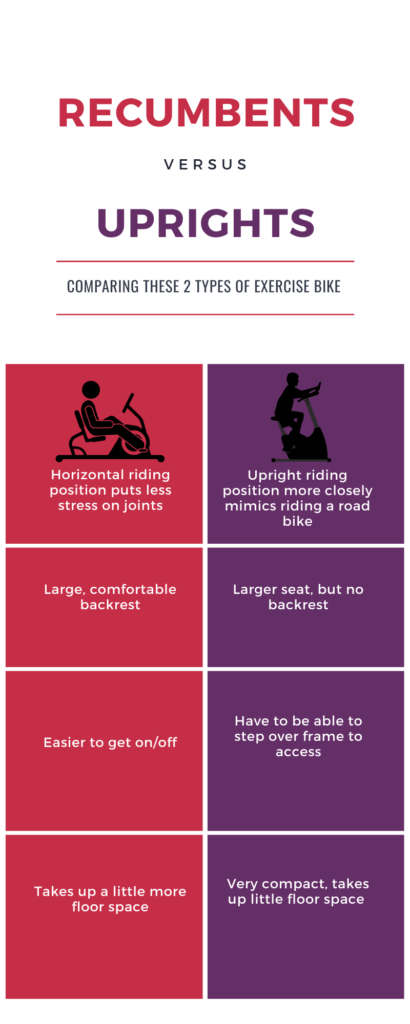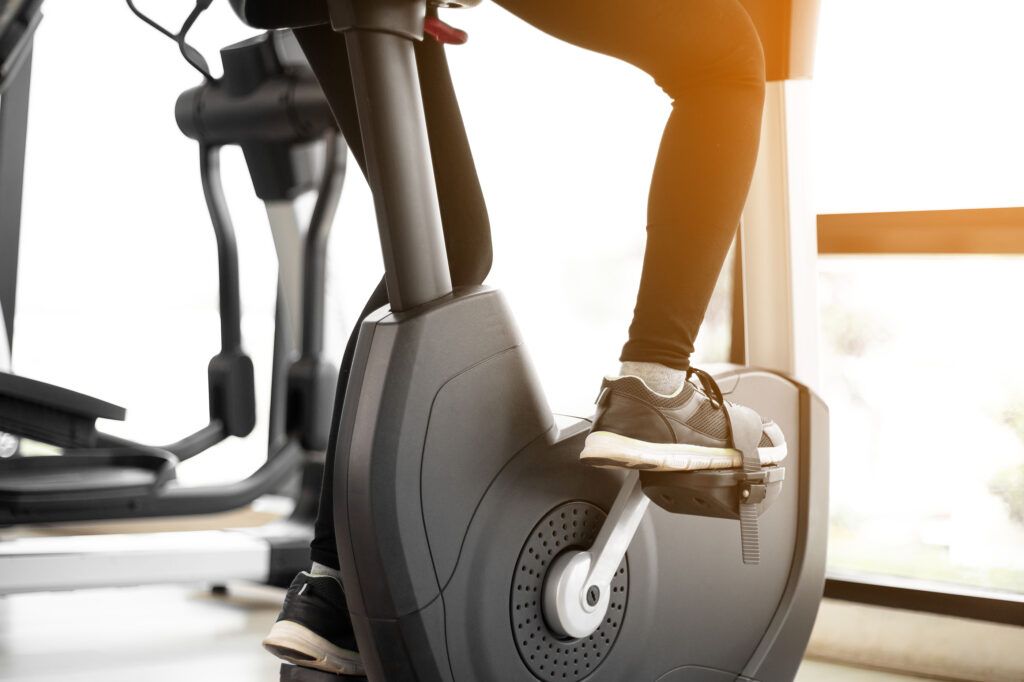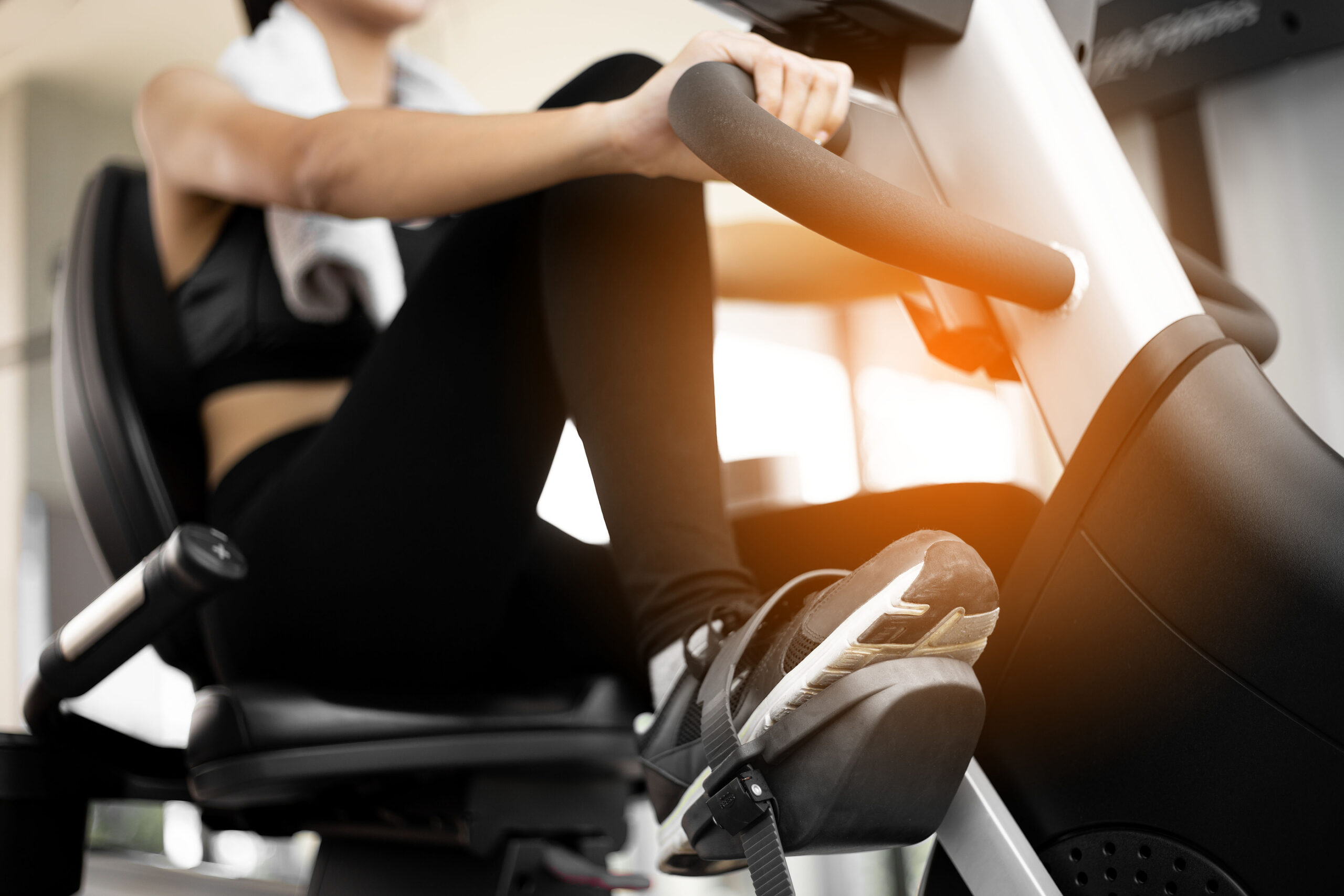It seems like indoor cycles get all the attention these days, but good ol’ fashioned recumbent and upright bikes are still around and they’re still going strong.
And even though these bikes aren’t usually as flashy as the spin bikes, they’ve still got a lot to offer- especially for folks dealing with achy joints or other mobility issues.
Recumbent and upright bikes each have their own benefits and disadvantages, so choosing the right option for your home really depends on what you’re looking for.
In this guide, I’ll go over the key differences between these 2 types of home exercise bikes. I’ll also provide my 2 cents on who I think would benefit from which style.
After reading, you’ll know everything you need to in order to decide which type of bike is the best option for your home.
Recumbent Bikes vs Upright Bikes

Is it me, or does it seem like indoor cycles have exploded in popularity over the last decade?
I’m assuming we have Peloton to thank for this.
I think it’s their huge success that’s got all these other fitness brands diving head first into the whole fitness streaming market.
And I get it- as a happy Peloton owner myself, I can attest first hand to how awesome the product is.
But not every bike needs to be a streaming indoor cycle!
I feel like we’re seeing new streaming bikes everyday now and it’s getting harder and harder to tell them apart.
Ok, that’s the end of my rant.
My point is (I think) that there are still other quality bikes out there that don’t require HD television screen monitors and monthly subscription fees.
For the folks out there that are looking for a more comfortable way to exercise, recumbent and upright bikes can make great options.
And even though we don’t see many commercials for these bikes, there are still a lot of great models to choose from.
Let’s start off with recumbent bikes first and go from there.
Recumbent Bikes 101

Recumbent bikes get their name from the reclined position of the seat.
On a recumbent bike, you’re oriented more horizontally than you are on any other type of bike, which is one reason these bikes are so much more comfortable to use.
Having your legs working horizontally (instead of vertically like on uprights and spin bikes) puts less stress on your knees.
The other obvious reason recumbent bikes are so much more comfortable is the large backrest you’ll find on most models. The seats on recumbents are also usually much bigger than the ones found on other styles.
The horizontal positioning + a large seat + a backrest = the most comfortable stationary bike.
The comfort factor a nice recumbent bike can provide is the biggest reason to choose this style of bike over any other, especially for folks who are dealing with chronic pain or achy joints.
I hate to generalize too broadly here, but most people can find a comfortable position to exercise on a recumbent bike.
This is why you see these machines in so many therapy clinics, rehab facilities, and assisted living facilities (ALF’s).
But they also make great options for home gyms, as long as you have the floor space- with the added comfort comes a larger footprint.
Recumbent bikes are easily the largest of all the exercise bikes, but even so they don’t take up that much space. The largest, nicest models will still only require a floor space of roughly 5′ x 3′ (L x W).
And even though recumbent bikes offer a more comfortable way to exercise, it doesn’t mean they can’t still provide a great workout.
As long as the resistance system is adequate, you can get an intense workout on these bad boys too (if you’re interested in learning more about how to choose the right recumbent bike, check out my full recumbent bike guide).
And you might think recumbent bikes are more expensive than the other models, but that isn’t really true either.
You can get some great home models between $500 – $1000. There are also plenty of more affordable recumbents out there, but like they say- you get what you pay for.
Who Should Buy A Recumbent Bike?
If you’re looking for a comfortable way to exercise, you should probably be considering a recumbent bike. After all, these bikes are designed for comfort and accessibility.
Most recumbents have a step-thru frame, meaning you don’t have to hike one leg up over the seat to access. Instead, you can step over the low bar of the frame to more easily sit on the large seat.
This makes them a lot easier to get on, especially for folks who have significant mobility deficits.
Folks with any of the following issues might also benefit from a recumbent model:
- Back pain
- Knee issues
- Hip issues
- Foot/ankle issues
- Limited activity tolerance
Basically anyone with any type of joint pain who’s concerned about being able to comfortably use an upright or spin bike will probably benefit from a recumbent.
The inclusion of a backrest makes sitting on these bikes a lot easier on the back and as I mentioned, the step-thru frame makes it a lot easier to get to the seat.
Upright Bikes 101

Upright bikes, or stationary bikes (although technically pretty much all exercise bikes are stationary with the exception of Bowflex’s Velocore) as they’re sometimes referred to, are kind of a middle ground between recumbents and indoor cycles.
Upright bikes are usually a little more comfortable than an indoor cycle, but not nearly as comfortable as a recumbent.
But unlike a recumbent, they still position you vertically like a traditional road bike.
With the growing popularity of indoor cycles, it’s conceivable that these bikes could go the way of the Dodo, but I don’t think that’s gonna happen anytime soon.
I still think they have too much to offer.
Uprights tend to come with a larger seat that’s a little more cushioned, making them easier to sit on for extended periods than spin bikes.
Like spin bikes though, these bikes don’t usually have backrests either, so you have to be comfortable with the idea of sitting unsupported while using them.
The consoles and handlebars on uprights are positioned a little higher than they are on indoor cycles, keeping you in a more vertical position than you’d be on a spin bike.
Upright bikes are very compact, taking up less space than a recumbent, so if floor space is an issue, an upright bike could be a smart choice.
Most uprights only require a floor space of 4′ x 2′ (L x W), allowing them to fit in pretty much any home.
And like recumbents, there are plenty of great options for home use that cost well under $1000 (many of the best options are in the $700 – $800 range).
In terms of features, you can find upright bikes that come loaded with workout programs or that can even stream workouts if that’s what you’re looking for.
You can also find ones that are bluetooth compatible and that pair easily with heart rate monitors.
For more info about finding the right upright bike, check out my full upright bike guide.
Who Should Buy An Upright Bike?
Upright bikes can work for pretty much anyone who isn’t limited by joint pain or mobility issues, but I think they’re best suited for folks who like the idea of a spin bike, but who are looking for a slightly more comfortable way to get that experience.
Like a spin bike, an upright puts you in a more vertical position, mimicking the experience of riding a road bike.
But with the larger and more comfortable seat (and the elevated handles), they’re usually more comfortable to sit on for extended periods.
Here’s a run down on the traits for folks who might prefer an upright bike:
- Comfortable sitting upright without a backrest
- Don’t have severe joint issues
- Able to step over frame to access seat
- Looking for more compact option
- Don’t want to go all-in with an indoor cycle
Basically, I think upright bikes are a great choice for people looking for a more comfortable way to get the spin bike experience.
Final Thoughts
There are significant differences between recumbent and upright bikes.
Recumbents are designed with access and comfort in mind, making these the best options for people who are dealing with joint pain or mobility deficits.
Uprights are more comfortable than spin bikes, but they still put you in a more vertical position, more closely mimicking the feel of riding a bike when compared to a recumbent.
Both bikes are gentler (is that a word?) to use than an indoor cycle.
And both bikes are very capable of providing a great workout.
There are also plenty of quality, affordable options for both types of exercise bike.
Well, that’s about all I’ve got when it comes to recumbents and uprights. If you have any further questions or comments, please leave ’em below and I’ll get back to ya soon.
You can also check out my individual guides for each type of bike for more info.




